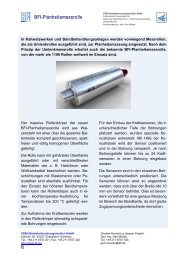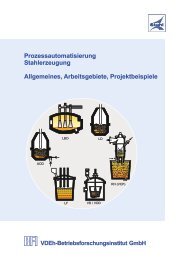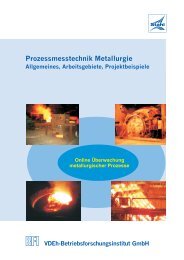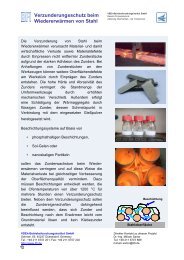Tätigkeitsbericht /Activity Report 2011/2012 - BFI.de
Tätigkeitsbericht /Activity Report 2011/2012 - BFI.de
Tätigkeitsbericht /Activity Report 2011/2012 - BFI.de
Sie wollen auch ein ePaper? Erhöhen Sie die Reichweite Ihrer Titel.
YUMPU macht aus Druck-PDFs automatisch weboptimierte ePaper, die Google liebt.
Energy and Resources | Resource Technologies<br />
Beim Einsatz betrieblicher Spülwässer zeigte sich,<br />
dass Säuredampf die Membran passieren kann, so<br />
dass ein Leitfähigkeitsanstieg im Permeat erfolgt<br />
und damit die Effektivität <strong>de</strong>r Spülwasseraufbereitung<br />
beeinflusst wird. Ggf. müsste daher das<br />
verbrauchte Spülwasser vor <strong>de</strong>r Behandlung mittels<br />
Membran<strong>de</strong>stillation neutralisiert wer<strong>de</strong>n.<br />
Bei <strong>de</strong>r Gefrierkonzentration wird das belastete<br />
Spülwasser auf Temperaturen unterhalb <strong>de</strong>s Gefrierpunktes<br />
abgekühlt. Dadurch bil<strong>de</strong>t sich salzfreies Eis<br />
im Spülwasser. Bei optimaler Prozessführung kann<br />
das Eis in hoher Reinheit erzeugt und anschließend<br />
vom verbleiben<strong>de</strong>n Spülwasser abgetrennt wer<strong>de</strong>n.<br />
Das verbleiben<strong>de</strong> Spülwasser soll dabei i<strong>de</strong>aler<br />
Weise so hoch aufkonzentriert wer<strong>de</strong>n, dass es<br />
in <strong>de</strong>n Beizprozess zurückgeführt bzw. in einer<br />
angeschlossenen Regeneration behan<strong>de</strong>lt wer<strong>de</strong>n<br />
kann. Somit ist es möglich, mit <strong>de</strong>m Prozess <strong>de</strong>r<br />
Gefrierkonzentration eine vollständige Kreislaufschließung<br />
ohne Reststoffe zu ermöglichen. Eine<br />
Ressourcenschonung wird nicht nur im Bereich <strong>de</strong>s<br />
Spülwassers son<strong>de</strong>rn auch im Bereich <strong>de</strong>r Frischsäuren<br />
erreicht.<br />
Im Rahmen <strong>de</strong>s Projektes wur<strong>de</strong>n Laborversuche<br />
zur Auswahl einer geeigneten Wärmetauschergeometrie<br />
durchgeführt. Darauf aufbauend wird<br />
aktuell eine Demonstrationsanlage entwickelt, die<br />
ein Gefrieren <strong>de</strong>s Eises und <strong>de</strong>ssen Abtrennung<br />
realisiert. Gleichzeitig wer<strong>de</strong>n insbeson<strong>de</strong>re die<br />
Steuer- und Regelparameter <strong>de</strong>s Kühlaggregates<br />
optimiert.<br />
Die Laborversuche an unterschiedlichen Wärmetauschergeometrien<br />
zeigten, dass eine <strong>de</strong>utliche<br />
Abreicherung von Ionen im Eis möglich ist. Mit<br />
einer Leitfähigkeit von ca. 3 mS/cm, wie sie bei<br />
einem Temperaturgradienten von 0,05 °C/min<br />
erreicht wur<strong>de</strong>, ist in einer mehrstufigen Spüle<br />
<strong>de</strong>r Einsatz in <strong>de</strong>r Zwischenspüle möglich. In <strong>de</strong>r<br />
Endspüle wird jedoch zumeist ein Zielwert von<br />
0,1 mS/cm gewünscht. Eine Optimierung wird an<br />
<strong>de</strong>r Technikumsanlage durch die Anpassung <strong>de</strong>r<br />
Prozessführung sowie <strong>de</strong>r Reglerparameter erfolgen.<br />
When rinsing water from industrial sources<br />
was used, it was found that acid vapours can<br />
pass through the membrane, resulting in higher<br />
conductivity of the permeate and thus diminishing<br />
the effectiveness of the rinsing water treatment.<br />
The used rinsing water may have to be neutralised<br />
before membrane distillation treatment.<br />
In the case of freeze concentration, the<br />
contaminated rinsing water is cooled to a temperature<br />
below the freezing point. This results in the<br />
formation of a nearly salt-free ice in the rinsing<br />
water. If the process is properly controlled, it<br />
is possible to produce ice with a high <strong>de</strong>gree of<br />
purity which can then be separated out from the<br />
remaining rinsing water. I<strong>de</strong>ally, the remaining<br />
rinsing water should be reconcentrated to an<br />
extent that it can be returned to the pickling<br />
process or treated in an associated regeneration<br />
plant. The freeze concentration process thus makes<br />
it possible to operate a closed loop without any<br />
residual substances. This conserves resources<br />
not only at the rinsing water level but also as<br />
regards the fresh acids.<br />
In the course of the project, lab tests were<br />
conducted to select an appropriate heat exchanger<br />
geometry. Building on this, a <strong>de</strong>monstration unit<br />
is now being <strong>de</strong>veloped which will allow freezing<br />
of the ice and its recovery. At the same time,<br />
the control and regulating parameters of the<br />
refrigeration unit are being optimised.<br />
Laboratory testing of different heat exchanger<br />
geometries showed that it is possible to significantly<br />
reduce the concentration of ions in the<br />
ice. With a conductivity of approx. 3 mS/cm,<br />
as achieved with a temperature gradient of<br />
0.05 °C/min, the resulting water could be used<br />
in the intermediate rinse of a multistage rinsing<br />
casca<strong>de</strong>. In the final rinse, the target value is usually<br />
0.1 mS/cm. The pilot plant will be refined still<br />
further by adapting the process control system<br />
and the controller parameters.<br />
Weiterentwicklung <strong>de</strong>r AOX-Messtechnik in<br />
wässrigen Proben und an Rohstoffen zur<br />
Vermeidung von Fehlmessungen<br />
In <strong>de</strong>n Industrien <strong>de</strong>s produzieren<strong>de</strong>n Gewerbes<br />
fallen Abwasserströme an, die adsorbierbare organisch<br />
gebun<strong>de</strong>ne Halogene (AOX) enthalten, die<br />
vor <strong>de</strong>r Ableitung kostenintensiv behan<strong>de</strong>lt bzw.<br />
© VDEh-Betriebsforschungsinstitut GmbH<br />
Further <strong>de</strong>velopment of AOX measuring<br />
technology for aqueous samples and for raw<br />
materials to avoid measurement errors<br />
Major production industries generate waste<br />
water streams that contain adsorbable organically<br />
bound halogens or hali<strong>de</strong>s (AOX) and have to be<br />
treated at great expense before being discharged<br />
23













